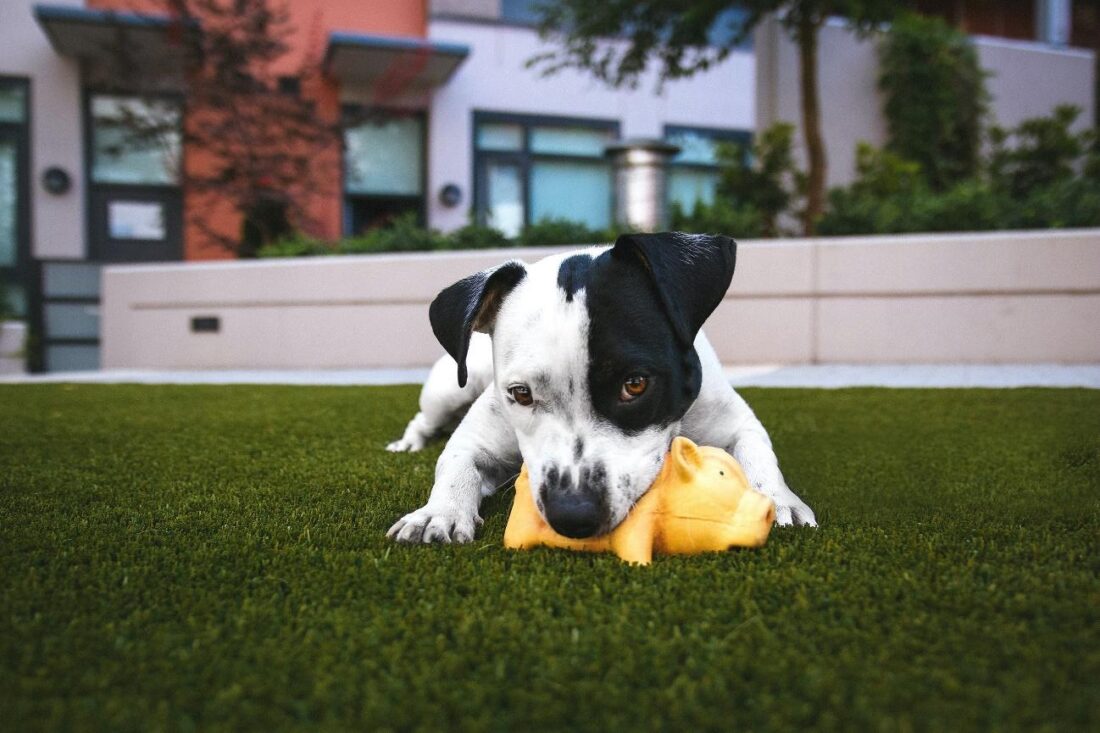Natural grass can get damaged easily by the activities of your pet, making it difficult for all pet owners to maintain a beautiful and pet-friendly outdoor space.
In recent years, there has been a significant surge in the pet turf industry. The idea of having a yard that is inexpensive and easy to maintain has excited all pet owners. They have come to recognize that pet-friendly artificial grass is resistant to issues like digging, mud, and the unsightly dead spots often encountered in natural grass lawns.
However, there are numerous pet-friendly artificial grass products in the market, and it can be difficult to select the one that is suitable for your lawn. Whеn facеd with thе plеthora of options availablе, look for an artificial grass installer who spеcializеs in pеt-friеndly solutions. Thеir еxpеrtisе can guidе you in sеlеcting thе pеrfеct product to transform your yard into a durablе, low-maintеnancе havеn for both you and your bеlovеd pеt.
In this article, we will learn about crucial factors that you need to consider when choosing the best pet-friendly artificial turf for your furry companion.
Conduct a Research
Conducting thorough research is essential when considering artificial grass for your home, as it involves a significant investment. So, take time to explore various types and determine which one aligns best with your budget and suits your pet’s needs.

Different brands offer varying levels of quality, drainage capabilities, and additional features. So, familiarize yourself with the fake grass varieties and make a checklist of attributes you desire for your lawn.
Familiarise Yourself with Pert Turf Terminology
Understanding pet turf terminology is essential to learn about different artificial grass components and the advantages of various features. This will help you to compare different brands and make informed decisions.
Here are some of the key terms that you will encounter when you shop for pet-friendly artificial turfs:
- Yarn
The yarn refers to the individual threads or fibers that make up the artificial grass. And the three main materials used for making artificial turfs are:
- Polyethylene: It is durable and has a soft texture, and is one of the most common materials used for manufacturing artificial grass.
- Nylon: It is the strongest yarn but is stiffer.
- Polypropylene: Though a cheaper material compared to the other two, it is less heat resistant.
- Thatch
Thatch is an additional layer of curly, brown threads in artificial grass, mimicking the dead grass under natural lawns. While not essential, it indicates a high-quality turf product. It is like a springy cushion that is comfortable for dogs and humans to walk on.
- Pile Height
Pile height refers to the length of the artificial grass fibers. Different pile heights serve different purposes, with taller piles creating a lush and realistic appearance. However, for a dog-friendly lawn, a shorter pile height is suitable as it can withstand heavy use from puppy paws. Moreover, it is easier to clean.
Compare Features of Pet-Friendly Artificial Grass Products
There are various Pet-friendly artificial grass options that are designed specifically for the safety and comfort of your pets.
Here are the features that you need to look for when shopping for pet-friendly turf options:
- Turf Backing
Artificial grass consists of two backings: primary backing and secondary backing.
The primary backing comprises a woven polypropylene grid where yarn fibers are tufted in rows, and the secondary backing, which is affixed to the back side of the grid to hold the grass fibers in place.
The combined weight of these backings is referred to as back weight. To ensure durability and prevent stretching or buckling, opt for a turf product with a back weight of 26 oz. or higher.
- Pet Turf Drainage
In addition to considering the backing weight, it’s crucial for pet-friendly turf to have effective drainage that allows water and pet urine to pass through. Proper drainage is essential to prevent the accumulation of bacteria, mold, or mildew, which can lead to unpleasant odors and potential harm to pets.
To prevent these issues, make sure that turf products are designed with one of the following drainage systems:
- Hole-Punched Backing
- Fully Permeable Backing
- DUAL FLOW Hybrid Turf Backing
- Antimicrobial
To combat the growth of bacteria, mold, and mildew in synthetic lawns, antimicrobial additives can be incorporated during the turf manufacturing process.
Ideal Turf’s artificial grass products, featuring Microbe Safe antimicrobial backing, effectively prevent the accumulation of pet urine odors, germs, and bacteria.
Your Budget and Financial Options
When considering pet-friendly artificial grass for your home, it’s essential to keep your budget in mind. While it offers numerous advantages, like low maintenance, increased home value, and improved curb appeal, the initial cost of purchase and installation might be higher compared to seeding or sodding.
For homeowners who intend to stay in their current residence for a long time, this is a valuable investment.
In addition, ideal turf provides additional support by offering various financing options to help homeowners spread out the initial cost of installing artificial grass.
Conclusion
Whether you have a dog or a cat, pet-friendly artificial turf is virtually indestructible, withstanding their playful activities without damage. Your pets can run freely and play without causing harm, and it’s even resistant to chewing. But when selecting the best turf for your pet, consider these factors to create a functional and pet-safe environment where they can run around all day and spend quality time with you and your family.




